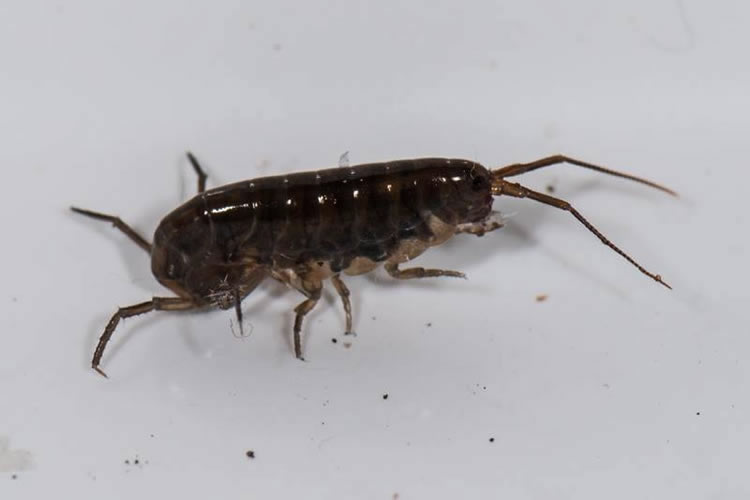Arcitalitrus dorrieni (Hunt, 1925)
Common name
Synonyms
Arcitalitrus sylvaticus (Haswell, 1879) (in part)
Status:
GB rarity status: Naturalised
ID Difficulty
Identification
The landhopper or woodhopper is an amphipod crustacean, and differs from isopods (e.g. woodice and waterlice) in having the body flattened from side to side (rather than top to bottom). It readily jumps into the air when disturbed (reminiscent of a very large flea - about 1 cm long!). It is the only amphipod that occurs inland on 'dry' (damp) ground and is characteristically dark (almost black) in colour.
Arcitalitrus dorrieni was once considered to be synonymous with A. sylvaticus, Haswell, 1879, but subsequently these have been shown to be distinct species. Unfortunately, the name A. sylvaticus has been used in the past and this has resulted in the confusion that two species of Arcitalitrus occur in Britain and Ireland. In fact, only one, A. dorrieni, has been recorded (Gregory, 2016).
Confusion is most likely with the introduced semi-terrestial amphipod Cryptorchestia garbinii Ruffo, Tarocco & Latella, 2014 (recently split from C. cavimana (Heller, 1865)), which is less darkly pigmented and although able to penetrate far inland it rarely strays far from water margins. The two species are described and figured by Gregory (2016). Other British 'terrestrial' amphipods rarely occur far above the high tide mark on the coast and are often pale orange in colour (most are intertidal).
Three additional species of terrestrial landhopper have been recorded from inside heated tropical glasshouses. These are Brevitalitrus hortulanus Calman, 1912, Talitroides alluaudi (Chevreux, 1896) and T. topitotum (Burt, 1934).
Distribution
A native of eastern Australia Arcitalitrus dorrieni was originally discovered on the Isles of Scilly in 1924 and a decade later also found in Co. Galway, western Ireland. It is now well established in south-western England and occurs patchily along the western coasts of Britain as far north as the Scottish Western Isles. It appears to be continuing its spread in southern and western areas, and beginning to colonise eastern Britain (Gregory, 2016). In Ireland it has proved frequent in Northern Ireland, with scattered records elsewhere.
It appears to be widely distributed on the Channel islands and recently A. dorrieni has been recorded from several sites in north-west France (Noel et al., 2021, article 7).
Habitat
It typically occurs under stones and dead wood or among damp detritus and debris in gardens, damp scrub and woodland. It may be abundant when found. It is probably widely spread via plant nurseries and garden centres. Alexander (2010) reports its occurrence from traps set adjacent to tree trunks 2 m above ground level in parkland in Cornwall.
References
Gregory, S.J. (2016) On the terrestrial landhopper Arcitalitrus dorrieni (Hunt, 1925) (Amphipoda: Talitridae): Identification and current distribution. Bulletin of the British Myriapod & Isopod Group 29: 2-13.
Links
WoRMS - World register of marine species~ https://www.marinespecies.org/aphia.php?p=taxdetails&id=103197









